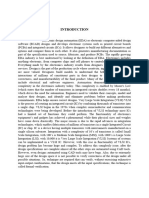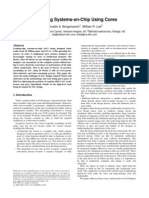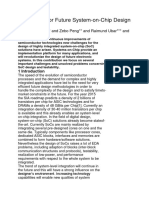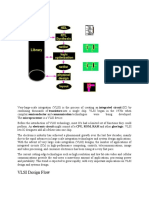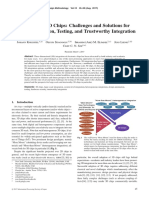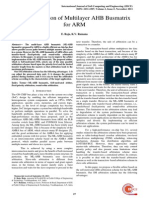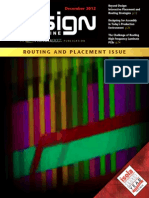Chapter 1: The Challenges of Complex Design
Chapter 1: The Challenges of Complex Design
Uploaded by
Anonymous pHi4dXCopyright:
Available Formats
Chapter 1: The Challenges of Complex Design
Chapter 1: The Challenges of Complex Design
Uploaded by
Anonymous pHi4dXOriginal Title
Copyright
Available Formats
Share this document
Did you find this document useful?
Is this content inappropriate?
Copyright:
Available Formats
Chapter 1: The Challenges of Complex Design
Chapter 1: The Challenges of Complex Design
Uploaded by
Anonymous pHi4dXCopyright:
Available Formats
Pre-publication excerpt from The Art of Good Design by Mike Keating (keating@synopsys.com) for review only.
Redistribution by permission only.
Chapter 1: The Challenges of Complex Design
The Problem
As semiconductor technology relentlessly pursues the path described by Moores law, the challenges of SoC design continue to grow dramatically. We are moving from chips with millions of gates to ones with billions of gates. The task of designing such complex systems is daunting. On the other hand, the basic design approach for digital design how we code Verilog or VHDL to describe complex functionality has remained largely unchanged in the last ten years. It is time to explore how to migrate our design methodology forward to meet the challenges of designing highly complex digital systems.
Divide and Conquer
Divide and conquer is the key tool for solving many complex problems. The effective design of complex systems relies on the same principle: the partitioning of the system into appropriately sized components and designing good interfaces between them. This book explores how to apply this fundamental technique to the design of complex hardware, in particular to SOC design. The process of designing complex chips is itself a complex system. In the early days, the IDM (Independent Device Manufacturers) model was common. A single company (such as LSI Logic in the 1980s) could have its own EDA tools, its own process, its own fab, and its own design teams. Today, this complex system has been partitioned into separate subsystems.
Copyright 2009 by Synopsys, Inc. All rights reserved.
Pre-publication excerpt from The Art of Good Design by Mike Keating (keating@synopsys.com) for review only. Redistribution by permission only.
EDA companies develop the tools to do design and provide them to the entire community. In general, design tools are simply too complex for design houses to develop on their own. Similarly, fabs have become too expensive for most semiconductor companies to build and maintain. Instead, independent fab houses such as TSMC, UMC, Chartered, and SMMIC specialize in manufacturing complex chips and in designing and maintaining the latest semiconductor processes. This repartitioning of the chip design process shows the basic principles of divide and conquer in action. When systems become too complex, it is more efficient to divide the system into several smaller components, and have a formalized interface between them. These interfaces are not free. Interfacing to an outside fab house is not trivial: the design files that one delivers to TSMC must meet TSMC's specifications and requirements. It also costs a significant amount of money to build chips at a commercial fab. But as the cost and complexity of fabricating chips rose, the cost of the interface became worthwhile. That is, TSMC (and others) hide the complexity of the manufacturing process from its customers and provide a relatively simple, formalized interface that allows designers to create chips without knowing the details of the manufacturing process. This decoupling effect is the key to good interface design. The partitioning of the system, and the design of good interfaces between its components, results in reducing a large, complex, flat problem into a set of small problems that can be solved locally. It decouples the complexity of one component from the complexity of another. The different tasks involved in digital design have also evolved over the years. In the late 1980s, synthesis was introduced, using tools to provide the optimization of digital circuits. In the 1990s, design reuse became a common methodology as chip designers realized it was more efficient to buy certain common components such as processors and interfaces and focus their design efforts on differentiating blocks. In recent years, the verification of complex IP and SOC designs has become so challenging that specialized verification languages and verification engineers have emerged as key components in the design process. Thus, the process of designing complex chips is continually evolving. At each step, we have addressed the increasing complexity of design by separating different aspects of design, so that each aspect or task can be addressed independently. RTL and synthesis technology allows us to describe circuits independently from a specific technology or library. Design reuse and IP allow us to separate the design and verification of complex blocks from the design of the chip itself. Recent improvements in verification technology have occurred as design and verification have become separate functions in the design team. This book outlines the most advanced techniques for using the divide and conquer as an approach to complex digital design. It also outlines some future directions for further partitioning of the problem, as we address the challenges of tomorrow's chip designs.
Copyright 2009 by Synopsys, Inc. All rights reserved.
Pre-publication excerpt from The Art of Good Design by Mike Keating (keating@synopsys.com) for review only. Redistribution by permission only.
The General Model
In general, then, the design of a complex system consists first of decomposing it into component parts. Figure XX show a cell phone as an example.
The phone contains a printed circuit board with a (small) number of key chips. The complex chips (SoCs) consist of a number of subsystems. Each subsystem consists of a number of IP. Each IP in turn consists of a number of subsystems or layers, and each subsystem consists of a number of modules. The module is the leaf level of this hierarchy. This is where the detailed design is done. It consists of HDL code describing the detailed function of the design. Note then that there are multiple levels of design: Product design (the cell phone) PC board design SoC design IP design
At each level of design, we decompose the design problem into a set of components. For instance, at the SoC design level, we define the functional units of the design and the IP we will use for each functional unit. Then we must compose these units into the system
Copyright 2009 by Synopsys, Inc. All rights reserved.
Pre-publication excerpt from The Art of Good Design by Mike Keating (keating@synopsys.com) for review only. Redistribution by permission only.
itself. That is, we need to decide how to connect the IP together (at the SoC design level) or how to connect the modules together (at the IP design level). At every level of design, this composition function consists of designing the interfaces between units. The design of these interfaces is one of the key elements in controlling the complexity of the design. For a good design, the design units (modules, IP, or chips) must be designed to have interfaces that isolate the complexity of the unit from the rest of the system. We will talk much more about this throughout the book. The general paradigm then is shown in figure XX.
Rule of 7
At any level of hierarchy, the number of blocks in the design is not arbitrary. In the 1950s, two psychologists (XX) published a paper called "The Magic Number Seven Plus and Minus Two". In this paper, they demonstrated that the human mind can hold seven objects (plus and minus two) at any one time. This is why telephone numbers (at least in the United States) are seven digits. We can remember seven digit phone numbers. We cannot remember 12 digit phone numbers. Similarly in any design, we can at any one time understand a design of up to seven to nine blocks.
Copyright 2009 by Synopsys, Inc. All rights reserved.
Pre-publication excerpt from The Art of Good Design by Mike Keating (keating@synopsys.com) for review only. Redistribution by permission only.
Compare the two block diagrams in figure XX. In the diagram on the left we see only five or six high-level components. It is easy to understand the major components of the system and how they are related to each other. In the diagram on the right, much more detail is shown. This makes it significantly more difficult to understand the general functions. When we look at the diagram on the right we tend to focus in on one subsystem the time, and try to understand what it does. Then we look at the larger diagram in front look at the general, high-level functionality.
This is a common problem in design. To design effectively, we need at any one time to be looking at only a small number of design objects. By doing so, we can think effectively about the (sub)system we are designing.
Tightly Coupled vs. Loosely Coupled Systems
Once we have partitioned the system or design into an appropriate number of design units, the key step is to design the interfaces between them. In general, systems can be considered to be one of two types, based on what kind of interfaces they have: tightly coupled or loosely coupled. Tightly coupled systems have interfaces that essentially connect the elements of the system into one single, flat unit.
Copyright 2009 by Synopsys, Inc. All rights reserved.
Pre-publication excerpt from The Art of Good Design by Mike Keating (keating@synopsys.com) for review only. Redistribution by permission only.
One example of a tightly coupled system is the weather. In 1961, Edward Lorenz (XX) was doing computer modeling of weather systems. He decided to take a short cut, and entered .506 for one variable, where earlier he had used .506127. The result was a totally different weather pattern. Later, he published a paper describing this surprising effect. The title was Does the flap of a butterflys wings in Brazil set off a tornado in Texas? His key discovery was that small, local effects can have large, global effects on the weather. This is typical of a tightly coupled system. Local causes can have global effects and local problems can become global problems. In SoC design, a tightly coupled system is one where the interfaces between units create such tight interaction between the units that they essentially become a single flat design. Thus, a change to any unit in the design may require changes to all the other units in the design. Also, fixing a bug in anyone unit may require significant changes to other units. A loosely coupled system, on the other hand, uses interfaces to isolate the different units in the design. An example of a loosely coupled system is a home video system.
Copyright 2009 by Synopsys, Inc. All rights reserved.
Pre-publication excerpt from The Art of Good Design by Mike Keating (keating@synopsys.com) for review only. Redistribution by permission only.
Although the DVD player, the set-top box, and the TV set are all very complex systems, the interface between them effectively isolates this complexity. The HDMI cable that connects the set-top box to the LCD display isolates the complexity of the set-top box from the display. The display does not need to understand anything about the internal behavior of the set-top box. All it has to do is understand the signals coming over the HDMI cable. More importantly, if the set-top box breaks, I can still use the DVD player. Local bugs or defects in the set-top box do not become global problems for the entire system. There are significant advantages to loosely coupled systems. But there are advantages to tightly coupled systems as well. Tightly coupled systems can be more efficient. This is one of the reasons they occur in nature so often. It is also one of the reasons why many design teams prefer to do place and route flat. The characteristics of a tightly coupled system are: they can be more efficient than loosely coupled systems they allow for global optimization less planning is required they are harder to analyze local problems can become global problems they can result in emergent behavior that is, big surprises Characteristics of a loosely coupled system are: they are more robust they support the design of larger systems they are easier to analyze
Copyright 2009 by Synopsys, Inc. All rights reserved.
Pre-publication excerpt from The Art of Good Design by Mike Keating (keating@synopsys.com) for review only. Redistribution by permission only.
local problems remain local they require more design and planning effort they produce more predictable results
One comment on the emergent behavior. The academic discipline of complex systems theory has devoted a lot of effort in studying naturally occurring tightly coupled systems. They study complex systems in biology, sociology, economics, and political science. They have found that complex (tightly coupled) systems frequently exhibit surprising and unpredictable behavior. This seems to result from the fact that it is not possible to analyze tightly coupled complex systems by decomposing them into components and analyzing the behavior of individual components. So much of the behavior of these complex systems resides in the interfaces, that any analysis of the system requires an analysis of the entire system as a flat entity. In highly complex systems, it becomes impossible to come up with a simple model that can be analyzed in simulated and get accurate results. One classic example of this is an anthill. The behavior of an individual ant is extremely simple. But an entire colony of ants can exhibit quite complex behavior, including complex strategies to locate and acquire food, complex strategies for defending the colony against invaders, and in extraordinary circumstances even moving the entire colony. There is no way one can predict this kind of behavior from an analysis of the individual ant. See (XX and XX) for more details. The lesson for designers of SOC's is that tightly coupled systems are much more likely to exhibit unexpected behaviors than loosely coupled systems. In particular, tightly coupled hardware systems are more likely to fail in unexpected and catastrophic ways than loosely coupled systems. Thus, one of the keys to the good design of SOC's is to make sure that they are loosely coupled systems.
The Challenge of Verification
One of the biggest challenges in digital design today is achieving functional correctness. As designs become larger and more complex, the challenge of functional verification has become extremely difficult. In particular, a number of new, sophisticated verification techniques have been added to the engineer's toolbox: constrained random testing, assertion-based testing, and formal verification. Unfortunately, these new techniques merely extend the previous trend in verification. We know that with more effort (and more sophisticated tools) we can find more bugs. But we have no useful model for how to find all of them.
Copyright 2009 by Synopsys, Inc. All rights reserved.
Pre-publication excerpt from The Art of Good Design by Mike Keating (keating@synopsys.com) for review only. Redistribution by permission only.
A quantitative analysis is compelling. There is little reliable data for bug rates in RTL code, but there is a very large amount of data on software quality. Since in both cases we are using code as a means of design, it is likely that we can extrapolate some useful information from the software quality studies. One software study (XX) shows that during coding, designers inject approximately 1 defect for every 10 lines of code. The process of compiling, reviewing, analyzing, and testing the code reduces this rate. For typical new code that has been well tested, a remaining defect rate of six to seven defects per thousand lines of code (KLOC) is common. The very best code from the most sophisticated teams can achieve one defect per KLOC (XX). With multiple uses in multiple products, and with extensive customer usage, this defect rate can be driven even lower. But as far as this author knows, no one has reported a defect rate significantly below .1 defect per KLOC in any large software program. It is likely that hardware teams commonly achieve the same kind of defect rate is the very best software teams. One reason for this is that hardware teams typically invest significantly more resources in verification and software teams do. But all the evidence indicates that any code base design of significant size will still have residual effects even after the most rigorous testing effort. As we build more and more complex chips, even very low defect rates such as .1 defect per KLOC can be a major problem. In fact, functional bugs are the largest single cause of chip respins (XX). For example: Consider a 50 million gate design. This corresponds to approximately 10 million lines of code. At .1 defect per KLOC, this means that the chip is likely to ship with 5000 defects.
Copyright 2009 by Synopsys, Inc. All rights reserved.
Pre-publication excerpt from The Art of Good Design by Mike Keating (keating@synopsys.com) for review only. Redistribution by permission only.
There are two primary strategies for improving the situation: reduce the number of lines of code lower the defect rate per thousand lines of code In this book, we will discuss design techniques for implementing both of these strategies by raising the level of abstraction in design.
The Pursuit of Simplicity
One key element in lowering the defect rate in RTL code is to make the code easier to understand. Even today, the most powerful verification tool in our toolbox is the human mind. Consistently, studies indicate the design reviews and code reviews are the most productive means of detecting bugs(XX). Today, most RTL code has been written with the primary goal of making it easy for the compiler (synthesis tool) to produce good results. However, this has often resulted in code that is difficult to understand. All of us have written code, only to come back to it months later and find that we have no idea what the code actually does. Unfortunately, code that is difficult to understand is also difficult to review and for humans to detect bugs. One of the goals of this book is to describe some techniques for simplifying RTL designs (by minimizing the state space) and to simplify the way this design is represented in the code itself. Whether we are building houses, bridges, networks, or complex chips, as the systems we build become more complex, their basic structure needs to become simpler and more regular.
The Changing Landscape of Design
Another reason for this pursuit of simplicity is that chip design has changed in a fundamental way over the last decade. A dozen years ago, it was possible for a single senior engineer to understand every aspect of the chip -- the overall architecture, what each module does, and how software interacts with it. In a finite amount of time, a single reviewer could read all of the RTL for a chip. Those days are gone. Today an SoC consists of many pieces of IP, often purchased from third-party IP providers. It also requires large amounts of software, from low-level drivers to high-level applications. The RTL for a complicated piece of the IP may be as large as an entire chip was just a few years ago. As result, no one engineer completely understands every aspect of an SOC design. No single human being could read all of the RTL for such a design. The design, verification, and debug a complex chip now requires an entire network of engineers. Copyright 2009 by Synopsys, Inc. All rights reserved. 10
Pre-publication excerpt from The Art of Good Design by Mike Keating (keating@synopsys.com) for review only. Redistribution by permission only.
As a side effect, during verification and debug, engineers are constantly dealing with code that they did not write, in which they may never have looked at before. They may not be experts on the bus protocols used on the chip or the interface protocols used in the I/O for the chip. Another way to look at this paradigm shift is this: in previous generations of design, chips were designed by teams of engineers. Now they are designed by a network of engineers. Managing this network is much more complex than managing a team. In this new model for chip design, there is a premium on simplicity: a simple, regular architecture, robust IP's that are easy to integrate, and code that is easy to read and understand.
Structure of This Book
Chapter 2 gives a brief overview of techniques for simplifying designs. Chapter 3 gives a detailed example of how to re-factor an RTL design to make it significantly less complex. It uses a control dominated design as the example. Chapter 4 discusses in more detail the concept of state space, and how to minimize it. Chapter 5 describes how the techniques described in previous chapters can simplify and improve verification. Chapter 6 gives another detailed example of simplifying code, this time with a data path intensive design. Chapter 7 describes how the design of module interfaces affects the complexity of the design. Chapter 8 continues the discussion in Chapter 7, and extends it to the IP and system level; it describes how to measure and minimize complexity of complete designs. Chapter 9 discusses the question of what techniques we can use with todays tools and languages, and what extensions we need to make in order to meet the needs of tomorrows designs. Chapter 10 describes the opportunities and challenges in using untimed models as synthesizable, executable specifications. Extensive examples are provided in XX.
Copyright 2009 by Synopsys, Inc. All rights reserved.
11
You might also like
- Digital System EngineeringDocument635 pagesDigital System Engineeringkakoli_bhatt9091% (11)
- Inventory Management System Project ReportDocument108 pagesInventory Management System Project Reportfcleong6967% (9)
- Module 11 Tape OutDocument8 pagesModule 11 Tape OutMuhammad SyameerNo ratings yet
- Ctcollab BookDocument575 pagesCtcollab BooknscintaNo ratings yet
- Systems On Chip: Evolutionary and Revolutionary TrendsDocument8 pagesSystems On Chip: Evolutionary and Revolutionary TrendsatsoumNo ratings yet
- Asv Platform Based2Document13 pagesAsv Platform Based2ultimatekp144No ratings yet
- The Impact of AI Technology On VLSI Design: Robert S. KirkDocument14 pagesThe Impact of AI Technology On VLSI Design: Robert S. Kirkthasarathanr1993_939No ratings yet
- CSC 322 Computer Architecture 2Document3 pagesCSC 322 Computer Architecture 2Class wrapperNo ratings yet
- The System On Chip TechnologyDocument6 pagesThe System On Chip TechnologyKonda PrashanthNo ratings yet
- A Lean Fabless Semiconductor Business ModelDocument7 pagesA Lean Fabless Semiconductor Business ModelRajatNo ratings yet
- Onur 447 Spring15 Lecture2 Isa AfterlectureDocument57 pagesOnur 447 Spring15 Lecture2 Isa AfterlectureHamedNo ratings yet
- Online Course On Embedded SystemsDocument75 pagesOnline Course On Embedded SystemspandiNo ratings yet
- Thesis Topics Embedded SystemsDocument8 pagesThesis Topics Embedded Systemsglennabeitelspachersiouxfalls100% (2)
- System Design: Traditional Concepts and New ParadigmsDocument12 pagesSystem Design: Traditional Concepts and New ParadigmsArun MohanarajNo ratings yet
- VLSI Design FlowDocument10 pagesVLSI Design Flowuday93No ratings yet
- Seven Steps To Embedded Designs Made Easier With Psoc CreatorDocument3 pagesSeven Steps To Embedded Designs Made Easier With Psoc Creatorsree2728No ratings yet
- Lecture - 0 CSE - 211 (Computer Organisation and Design)Document19 pagesLecture - 0 CSE - 211 (Computer Organisation and Design)Pitla RishithaNo ratings yet
- DSD LabDocument45 pagesDSD Labkumarravi955rNo ratings yet
- Designing Systems-on-Chip Using Cores: Reinaldo A. Bergamaschi, William R. LeeDocument6 pagesDesigning Systems-on-Chip Using Cores: Reinaldo A. Bergamaschi, William R. LeemnihajNo ratings yet
- PANEL: Tools or Users: Which Is The Bigger Bottleneck?: Chair: OrganizersDocument2 pagesPANEL: Tools or Users: Which Is The Bigger Bottleneck?: Chair: OrganizersTamiltamil TamilNo ratings yet
- 01 CSA Assignment QuestionsDocument5 pages01 CSA Assignment QuestionsSagaaboyz Mg RNo ratings yet
- Research Notes of MSPDocument27 pagesResearch Notes of MSPshailendra shindeNo ratings yet
- Chapter 6 - Essentials of Design and The Design ActivitiesDocument9 pagesChapter 6 - Essentials of Design and The Design ActivitiesBaby DollNo ratings yet
- 152 CusumanohightechDocument17 pages152 Cusumanohightechhornillos_elfuerteNo ratings yet
- Software Requirements: 3.1GENERALDocument24 pagesSoftware Requirements: 3.1GENERALRatnakarVarunNo ratings yet
- Godzilla: Seamless 2D and 3D Sketch Environment For Reflective and Creative Design WorkDocument8 pagesGodzilla: Seamless 2D and 3D Sketch Environment For Reflective and Creative Design Worksinghishpal24374No ratings yet
- Challenges For Future SystemDocument10 pagesChallenges For Future SystemkunalNo ratings yet
- Embedded SystemsDocument15 pagesEmbedded SystemsIge-Edaba OpanahNo ratings yet
- YPE Blockchain White - PaperDocument46 pagesYPE Blockchain White - PaperFrancisco CarvalhoNo ratings yet
- Embedded System Industrial TrainingDocument75 pagesEmbedded System Industrial TrainingTechTerms_YoutubeNo ratings yet
- Systemonchip DesignDocument6 pagesSystemonchip Designddeepikam229No ratings yet
- Tendencias en Sistemas Embebidos Segun NIDocument20 pagesTendencias en Sistemas Embebidos Segun NImilkux10No ratings yet
- Fundamentals of Floor Planning A Complex Soc: Andre HassanDocument6 pagesFundamentals of Floor Planning A Complex Soc: Andre HassanBaluvu JagadishNo ratings yet
- Embedded System Development Using SysML (Doug Rosenberg, Sam Mancarella)Document68 pagesEmbedded System Development Using SysML (Doug Rosenberg, Sam Mancarella)chenNo ratings yet
- Vlsi 1Document3 pagesVlsi 1devNo ratings yet
- Digital VLSI Design: T.Rajeswari (IN1729) Anusha G (IN1727)Document36 pagesDigital VLSI Design: T.Rajeswari (IN1729) Anusha G (IN1727)Sai KumarNo ratings yet
- Distributed Operating SystemDocument24 pagesDistributed Operating Systembubun_metal100% (1)
- ACA Notes UNIT-1Document20 pagesACA Notes UNIT-1Naivaidya NegiNo ratings yet
- CA Lecture 1Document28 pagesCA Lecture 1sibghamehboob6No ratings yet
- Systems A Shortcut To Manage Complex Design Jan 2014Document14 pagesSystems A Shortcut To Manage Complex Design Jan 2014Fábio SeabraNo ratings yet
- IEC-EN 60204-1-And-81346-September-2010Document14 pagesIEC-EN 60204-1-And-81346-September-2010carlosmandopintoNo ratings yet
- Katya Digital Electronics Assignment#2Document9 pagesKatya Digital Electronics Assignment#2Katia KisswaniNo ratings yet
- Computer DisassemblyDocument16 pagesComputer DisassemblyJulius PopoolaNo ratings yet
- Chapter 1 To 5 Training File1Document35 pagesChapter 1 To 5 Training File1Avtar Singh MalhiNo ratings yet
- Analogue Design: A Challenging But Satisfying Option: Embedded SystemsDocument7 pagesAnalogue Design: A Challenging But Satisfying Option: Embedded SystemsAnudeep TantravahiNo ratings yet
- Computer Fundamentals Assignment SrinadhDocument8 pagesComputer Fundamentals Assignment Srinadhsrinadh.ficoNo ratings yet
- Focus On: Path To SystemsDocument32 pagesFocus On: Path To SystemsCarlos H. CarneiroNo ratings yet
- L5 - Designing The Solution-HandoutDocument8 pagesL5 - Designing The Solution-Handoutabdallameme555No ratings yet
- Module 1 (Part 1)Document103 pagesModule 1 (Part 1)SAATHVIK SHEKARNo ratings yet
- Large-Scale 3D Chips: Challenges and Solutions For Design Automation, Testing, and Trustworthy IntegrationDocument18 pagesLarge-Scale 3D Chips: Challenges and Solutions For Design Automation, Testing, and Trustworthy Integrationyunfan yNo ratings yet
- Tarea1 Lara GarcíaDocument5 pagesTarea1 Lara GarcíalaramecaNo ratings yet
- The Embedded Systems Design ChallengeDocument16 pagesThe Embedded Systems Design ChallengeAbd ANo ratings yet
- Objectives:: CPS211 Lecture: Course Intro Introduction To Software EngineeringDocument7 pagesObjectives:: CPS211 Lecture: Course Intro Introduction To Software EngineeringDeeksha NarvariyaNo ratings yet
- Part 1 - Solution Design - Introduction and First PrinciplesDocument17 pagesPart 1 - Solution Design - Introduction and First Principles247 NarenderNo ratings yet
- VTU 8th Sem Cse QB With AnswersDocument137 pagesVTU 8th Sem Cse QB With Answersvmscse100% (1)
- "Design Consultant": A Network-Based Concurrent Design EnvironmentDocument7 pages"Design Consultant": A Network-Based Concurrent Design Environmentalex240574No ratings yet
- Embedded Systems Programming with C++: Real-World TechniquesFrom EverandEmbedded Systems Programming with C++: Real-World TechniquesNo ratings yet
- Systems Engineering for All: Introduction to Systems Engineering for non-Systems EngineersFrom EverandSystems Engineering for All: Introduction to Systems Engineering for non-Systems EngineersNo ratings yet
- Fundamentals of Modern Computer Architecture: From Logic Gates to Parallel ProcessingFrom EverandFundamentals of Modern Computer Architecture: From Logic Gates to Parallel ProcessingNo ratings yet
- PlayStation 3 Architecture: Architecture of Consoles: A Practical Analysis, #19From EverandPlayStation 3 Architecture: Architecture of Consoles: A Practical Analysis, #19No ratings yet
- Nabling Eusable N HIP Esigns: Amba: E R O - C DDocument8 pagesNabling Eusable N HIP Esigns: Amba: E R O - C DAnonymous pHi4dXNo ratings yet
- Dirty RFDocument236 pagesDirty RFAnonymous pHi4dXNo ratings yet
- Implementation of Multilayer AHB Busmatrix For ARM: E. Raja, K.V. RamanaDocument4 pagesImplementation of Multilayer AHB Busmatrix For ARM: E. Raja, K.V. RamanaAnonymous pHi4dXNo ratings yet
- PCBDesign Dec2012Document77 pagesPCBDesign Dec2012Anonymous pHi4dXNo ratings yet
- State Machine DesignDocument20 pagesState Machine DesignAnonymous pHi4dXNo ratings yet
- Microcoded ArchDocument12 pagesMicrocoded ArchAnonymous pHi4dXNo ratings yet
- New Microsoft Office Word DocumentDocument5 pagesNew Microsoft Office Word DocumentSukanya SinghNo ratings yet
- HEC HMS Dan Geo HMS Menggunakan Data Grid HujanDocument4 pagesHEC HMS Dan Geo HMS Menggunakan Data Grid HujanHarry ChaeruddinNo ratings yet
- Exercise Oracle Forms 6i TrainingDocument5 pagesExercise Oracle Forms 6i TrainingFarooq Shahid100% (1)
- General Questions: 1. What Is Java?Document125 pagesGeneral Questions: 1. What Is Java?api-3762312100% (1)
- Operating System - Memory Management: Process Address SpaceDocument10 pagesOperating System - Memory Management: Process Address SpaceNelson RajaNo ratings yet
- Use Manual EmbosipDocument314 pagesUse Manual EmbosipClyde CauchiNo ratings yet
- Firmware Upgrade Guide: Mobii 7 Inch Playtabpro Tab-Playtabpro (4R) Firmware Upgrade InstructionsDocument9 pagesFirmware Upgrade Guide: Mobii 7 Inch Playtabpro Tab-Playtabpro (4R) Firmware Upgrade InstructionswalidNo ratings yet
- Homework Operating SystemsDocument1 pageHomework Operating SystemssnobshitNo ratings yet
- Screen Os To SRX Acceleration PlaybookDocument13 pagesScreen Os To SRX Acceleration PlaybookPhyo Min TunNo ratings yet
- Javacc Tokenmanager Mini-TutorialDocument15 pagesJavacc Tokenmanager Mini-TutorialPablo Lorenzo Muños SanchesNo ratings yet
- An Introduction' To Computing With Neural Nets: Richard P. LippmannDocument19 pagesAn Introduction' To Computing With Neural Nets: Richard P. LippmannSathish Kumar KarneNo ratings yet
- Mathematical Morphology: Erosion Dilation Opening ClosingDocument34 pagesMathematical Morphology: Erosion Dilation Opening ClosingSanjay BhatikarNo ratings yet
- File 10: F:/Data - Sumit/Projects/Terna/Input/PCF File/50HTF15BR020 .PCFDocument2 pagesFile 10: F:/Data - Sumit/Projects/Terna/Input/PCF File/50HTF15BR020 .PCFVaniya GoelNo ratings yet
- Fusion ChartsDocument1,078 pagesFusion ChartskaoloNo ratings yet
- OMNet 4.0 ManualDocument361 pagesOMNet 4.0 ManualHari KrishnaNo ratings yet
- Schema HRDocument26 pagesSchema HRklerpabaratoNo ratings yet
- MSC Computer Science Syllabus 2016 17Document32 pagesMSC Computer Science Syllabus 2016 17sunnyNo ratings yet
- AMDPDocument14 pagesAMDPNaveen RajNo ratings yet
- Symmetric Encryption Algorithms Provided by SunjceDocument13 pagesSymmetric Encryption Algorithms Provided by SunjcestefomarNo ratings yet
- L14 - Wildcard QueriesDocument19 pagesL14 - Wildcard QueriesJagruti BorasteNo ratings yet
- NT Lab QuizDocument5 pagesNT Lab QuizAmit MishraNo ratings yet
- What Are The Three Ways That Computer Buses Can Be Used To Communicate With Memory and I/O?Document1 pageWhat Are The Three Ways That Computer Buses Can Be Used To Communicate With Memory and I/O?Safa MNo ratings yet
- 7000 - 7.5.10 Release NotesDocument5 pages7000 - 7.5.10 Release Notespaola m. palacios v.No ratings yet
- Week 05 Lecture 01 AStar Reading AssignmentDocument87 pagesWeek 05 Lecture 01 AStar Reading AssignmentOsama AdeelNo ratings yet
- Understanding Routing What Is Routing?Document17 pagesUnderstanding Routing What Is Routing?Sanjay Kumar MahanaNo ratings yet
- Spring Boot: Working With Application Runner: - by RAGHU SIR, Naresh ITDocument4 pagesSpring Boot: Working With Application Runner: - by RAGHU SIR, Naresh ITVenkat GowdaNo ratings yet
- Builder Design PatternDocument8 pagesBuilder Design PatternkasimNo ratings yet
- Citadel White PaperDocument13 pagesCitadel White PaperdsffgdsgsgasfgasfgNo ratings yet
- Cisco Unified Contact Center Express Solution Reference Network DesignDocument104 pagesCisco Unified Contact Center Express Solution Reference Network Designgreenwind007No ratings yet

















